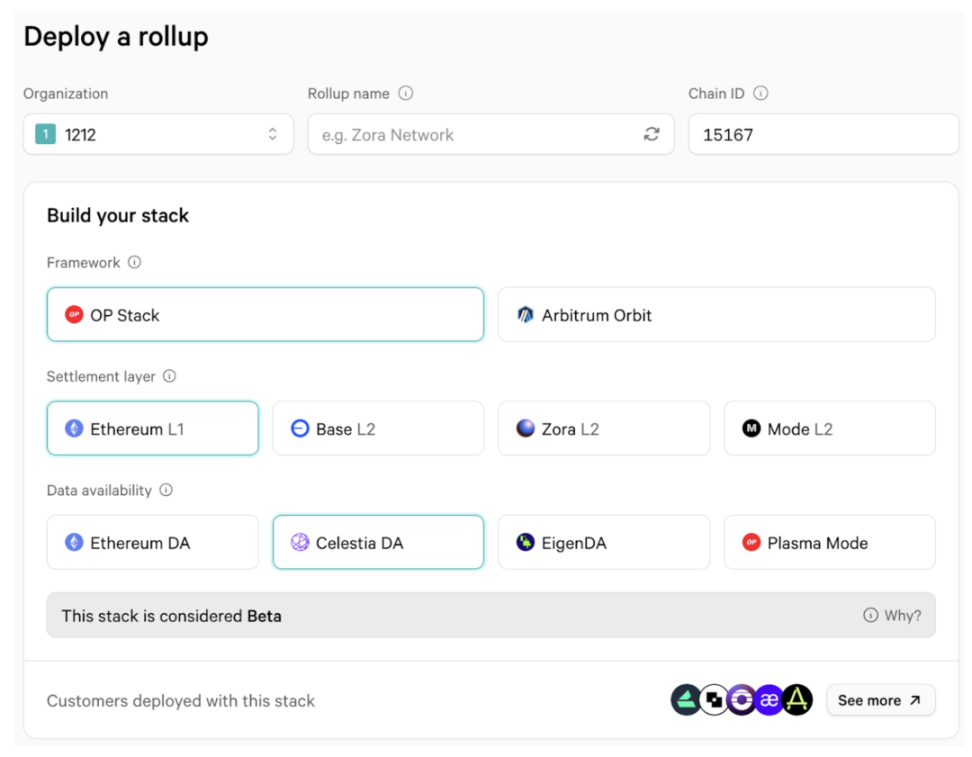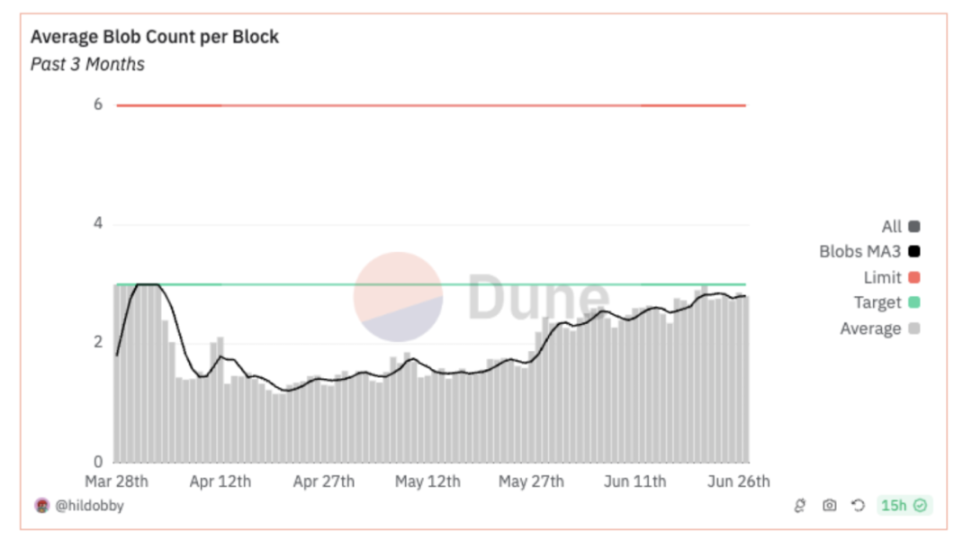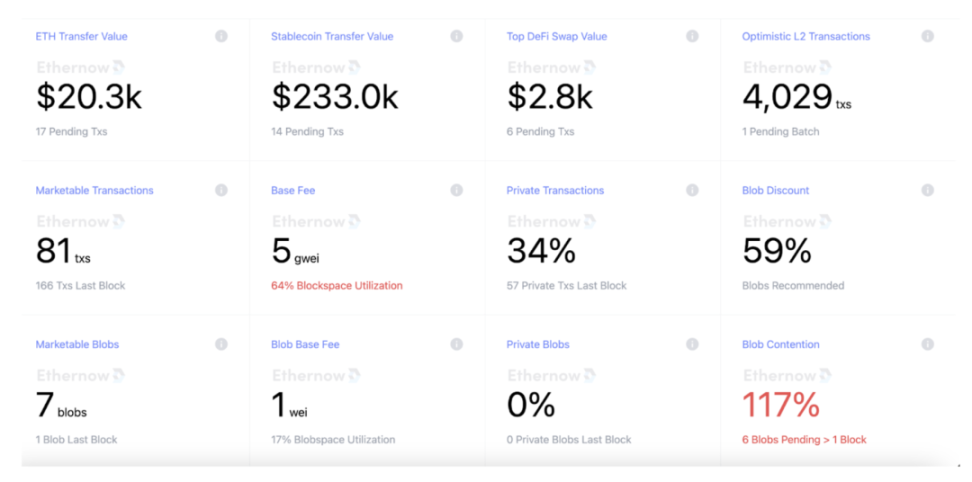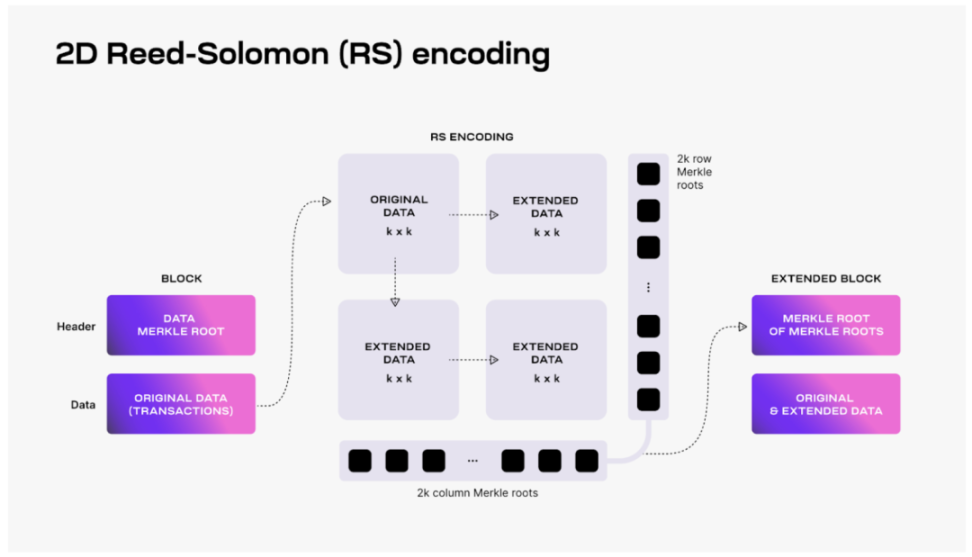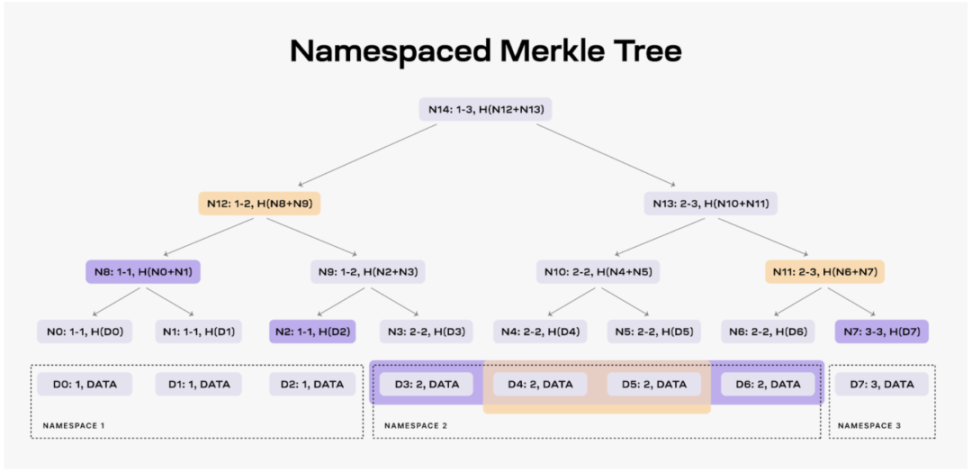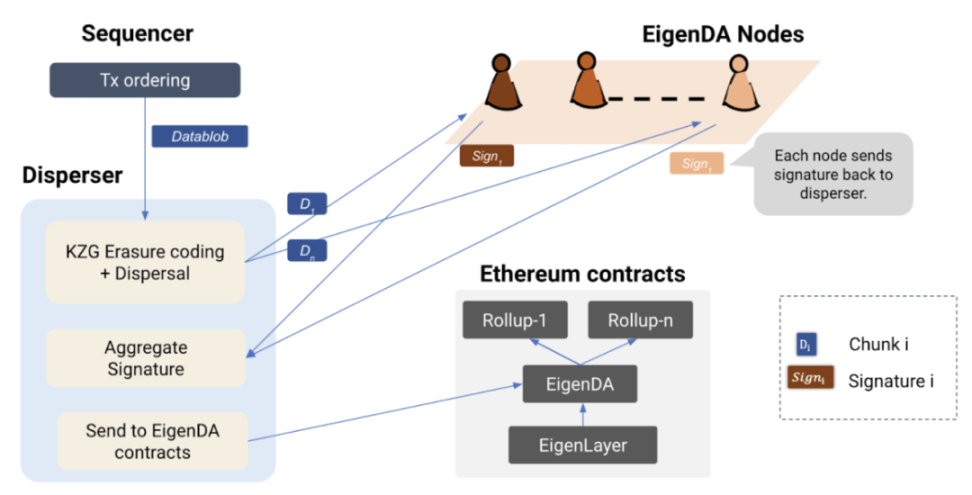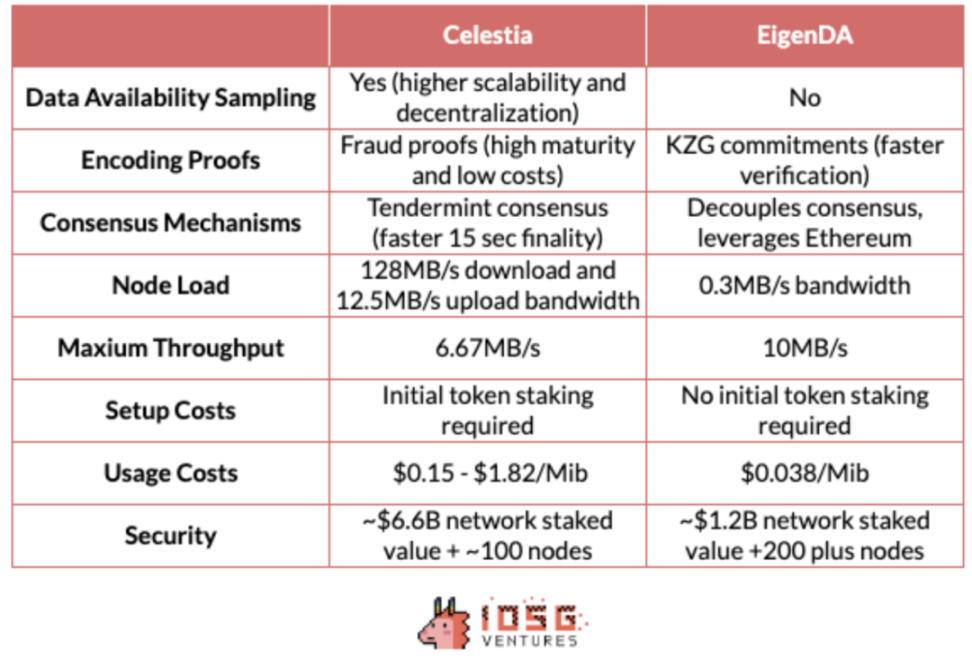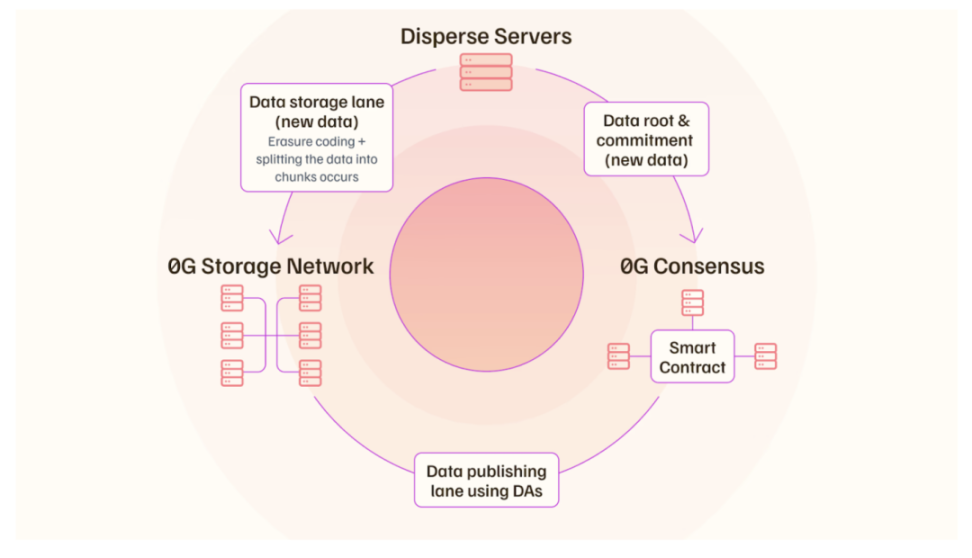原作者:IOSG Ventures
背景
兩年前,在模組化區塊鏈敘事興起之初,我們寫了一篇文章,提出了我們對數據可用性賽道的看法和預測。正如我們所預期的那樣,模組化區塊鏈敘事已經盛行,並促進了基礎設施創新,增強了網路互通性,並促進了生態系統內更多的合作和整合。各種 Rollup as a Service (RaaS) 解決方案(Altlayer、Caldera、Conduit、Gelato)已經開始出現。下圖是Rollup開發工具Conduit的介面,可見部署Rollup和選擇DA解決方案變得極為簡單方便。
來源:管道
近兩年來,Celestia、EigenDA、Avail、NearDA等替代DA解決方案(Alt-DA)取得了顯著進展,各自展現了獨特的技術優勢和市場份額。同時,隨著以太坊EIP-4844的推出,引進blob來取代calldata,大大降低了以太坊原生DA層使用Rollup的成本。如今,開發人員和專案所有者在選擇資料可用性層時面臨更多權衡。本文將對現有的DA解決方案進行追蹤分析,深入探討其性能成本、技術特性、市場表現,並對DA賽道未來的發展提出我們的看法與思考。
1. 目前DA解決方案的採用情況
使用以太坊原生 DA 鏈上解決方案的 Rollups 主要集中在從 calldata 儲存更新到適應 Blob 的主流 Layer 2 解決方案,包括 Arbitrum、Optimism 和 Base,以及 Starknet、zkSync 和 Scroll。透過使用以太坊作為DA層,Rollup的數據將由以太坊全節點驗證和存儲,並將受益於以太坊的安全性、去中心化程度、協議升級的連續性和經濟激勵。綜合L2在以太坊生態中佔據重要地位,需要原生DA帶來的上述正統作為核心差異。 (Vitalik認為rollup的核心是無條件的安全保證:即使所有人都反對你,你也可以提取你的資產。如果資料可用性依賴於外部系統,則無法獲得這種等效的安全性)
然而,向以太坊主網發布資料伴隨著高昂的成本,尤其是在 EIP-4844 之前(calldata 每位元組花費 16 個 Gas,僅 2023 年 12 月 L2 就在 DA 成本上花費了超過 15,000 ETH)。因此,出現了多種Alt-DA鏈下解決方案,如Celestia、EigenDA、Avail等,都推出了不同的技術手段,如DAS、糾刪碼、KZG承諾等,以減少資料儲存和傳輸的成本。
其中,Celestia作為專注於DA的模組化區塊鏈,自2023年10月主網上線後,已成為DA賽道的領先項目。層解決方案、defi 專案、遊戲、排序器和 Layer 2 解決方案,不限於以太坊生態系統。其現有客戶包括Omnichain DEX協定Orderly、為EVM原生ZK應用客製化的模組化L2 Manta Pacific、基於Base的L3 Hokum以及專注於衍生性商品交易的DEX Lyra和Aevo。作為不局限於特定生態系統的模組化設計 DA 層的先驅,Celestias 的優勢使其成為許多新興 Layer 2 項目的首選。
EigenDA由EigenLabs開發,利用EigenLayers重質押機制提供高效、安全、可擴展的DA服務解決方案,在一定程度上繼承了以太坊主網的安全性和龐大的驗證人網絡。 EigenDA專注於為以太坊生態系統提供高效能DA解決方案。作為 Eigenlayer 上第一個主動驗證服務(AVS),EigenDA 於 4 月與 Eigenlay 主網一起推出。現有的客戶群也多種多樣,包括以太坊L2 Swell、Celo、Mantle Network 以及基於Eigenlayer 構建的多個其他AVS,例如去中心化計算堆疊Versatus、Polymer、DEX 協議DODO 和作為Social L2 的Cyber Connect。
來源:EigenDA
2. 原生 DA (EIP-4844) 與現有 Alt-DA 之間的權衡
2.1 以太坊原生DA
讓我們簡單回顧一下以太坊原生DA解決方案的發展與變化。在坎昆升級之前,Rollup主要使用calldata作為資料儲存和傳輸的手段。由於永久儲存和高網路擁塞,高成本已成為擴展和採用的主要障礙。作為主網升級,EIP-4844 引進了新的資料結構 Blob。 Blob可以容納大量數據,但會相應增加節點的儲存負擔。隨著時間的推移,儲存需求將不斷增加,最終可能導致運行節點的硬體需求過高,損害去中心化。因此,Blob 只需要儲存約 18 天(4096 epoch)就可以被刪除。
由於 Blob 僅需要暫時儲存並使用單獨的費用市場,因此在 EIP-4844 實施後,採用 Blob 前後 60 天每個 L2 的平均每日 DA 成本(Scroll Starknet 前後各 30 天)為下降了約99%。由於上傳資料類型不同(交易資料或狀態差異),使用OP rollup的Layer 2相比Zk Rollup更能從成本降低中受益。
來源:沙丘生長派
EIP-4844 Blob 容量和儲存特性以及定價機制
Blob 容量和儲存特性:
-
每個區塊最多可容納 6 個 blob
-
每個 blob 最多可以儲存 128 KB 資料(即使未使用完整的 128 KB,發送者也將被收取全部 blob 費用)
一個新的 Blob Gas 市場,其運作方式與 EIP-1559 類似,根據供需變化調整 Blob 基本費用:
-
如果區塊中的 blob 數量超過目標(目前為 3),則增加 blob 基本費用。
-
如果區塊中的 blob 數量少於目標,則減少 blob 基本費用。
資料來源:IOSG 創投公司
來源:Dune / 以太坊區塊斑點 3 日移動平均線
L2主要使用新引入的類型3交易,在先前交易的基礎上增加了max_fee_per_blob_gas和blob_versioned_hashes欄位,分別代表用戶願意支付的每blobgas的最大費用和kzg_to_versioned_hash的哈希輸出清單。
這種新的定價機制意味著類型 3 交易仍然需要 max_fee_per_gas 和 max_priority_fee_per_gas 字段,並受現有 EIP-1559 市場的限制。除了blob空間之外,類型3交易仍然需要為其使用的EVM空間付費。
因此,對於 Blob 的區塊空間仍然存在競爭,導致成本不確定性,因為每個區塊中的 Blob 空間是有限的,並且 Blob Gas 費用市場根據需求動態調整。
因此,作為一條通用鏈,以太坊的弱點在於區塊空間的不確定性——可能會出現突然的 NFT 鑄幣、空投領取等鏈上活動,可能導致鏈上擁堵,從而導致 Blob 的定價上調,使得Rollup 無法估算成本基礎。這將導致Rollup支出預算的不確定性,導致利潤率不穩定,並增加尚處於起步階段的新專案的使用障礙。專案方很難確定以太坊DA是否可以作為長期解決方案。下圖中,大部分時候使用blob比calldata便宜98%左右,但在下圖中可以看出,在一定時間內使用Blobs只比使用Calldata便宜59%。
來源:Ethernow
我們以計算兩次 Blob 傳輸的成本為例:
來源:Ethernow
該圖顯示了 2024 年 3 月 28 日某個區塊中 Zksyncs Validator Timelock 的 3 類交易。
假設以太坊的價格為 $3600,那麼當時使用 1 Mib blob 資料的成本約為:
4 × 0.018 ETH × 3600 美元/ETH = 259.2 美元
讓我們再來看 6 月 24 日 zksync 時代的另一筆 3 類交易:
來源:Ethernow
當時主網活躍度略有下降,對其數據成本進行了細分計算:
當時使用 1 Mib blob 的數據成本約為:
4 × 0.0021 ETH × 3600 美元/ETH = 30.24 美元
這說明使用blob傳輸資料的成本是不確定的,而且仍然比較高。然而,對於總結而言,成本結構的穩定性是選擇 DA 解決方案時的關鍵考慮因素之一。
2.2 塞拉斯蒂婭
作為模組化區塊鏈的先行者,Celestia 專注於提供 DA 層和共識層,分離執行層,從而針對性地優化 DA 功能,提高效率和可擴展性。 Celestia作為鏈下解決方案L1,與以太坊鏈上的方法相比,具有許多不同的技術特點,從而降低了資料可用性的成本,並提供了相對更高的靈活性和可擴展性。模組化的設計使得Celestia極為靈活,允許開發者自由選擇執行環境,而不必局限於特定的虛擬機器(VM),讓Celestia能夠支援多種不同的應用場景,滿足多樣化的需求。
如果Rollup想要整合Celestia作為DA層,則需要將執行層產生的交易資料(Data Blob)提交到Celestia網路而不是原始的Layer 1(以太坊),以確保驗證和交易的資料可用性。 Celestias數據可用性採樣(DAS)技術採用二維RS糾刪碼編碼方案對區塊數據進行重新編碼,讓輕節點僅下載一小部分區塊數據,透過多輪隨機採樣來驗證數據的可用性,並允許多個節點並行處理資料的不同部分,提高整體效率。
資料來源:Celestia.org
過程中的另一個關鍵技術是Celestia引入的Namespace Merkle Tree(NMTs)技術,該技術允許不同的rollup只下載與自己相關的交易數據,從而提高數據處理效率。 NMT不僅減少了資料冗餘,提高了系統效能,也為開發人員提供了更有效的資料處理方式。
在安全性方面,Celestia基於Tendermint共識機制。驗證者就Data Blob達成共識,以確保網路中資料的可用性和一致性。它可以容忍多達三分之一的驗證節點的故障或惡意行為。透過質押 TIA 代幣,Celestias 驗證者將獲得經濟激勵,以確保誠實行為,並對惡意行為或不當操作進行處罰,從而確保網路的安全。目前,Celestias TVL約為US$64.4億,全節點數為100個。
在可擴展性方面,Celestias 區塊大小可以根據網路中活躍輕節點的數量進行動態調整。隨著更多節點的加入,Celestia 可以安全地增加區塊大小,理論上無限增加吞吐量和可擴展性。目前數據顯示其數據吞吐量約為6.67MB/s。
Celestia Blob 容量和儲存功能以及定價:
為了進行成本比較,我們簡單討論一下 Celestia 的效能和定價機制。當用戶在 Celestia 上提交資料時,他們會透過提交 Blob 交易(BlobTx)來完成,費用包括 Blob 空間費和 Gas 費用。
具體來說,每個 Blob 的最大大小限制略小於 2 MiB(1,973,786 位元組),並且每個區塊可以包含多個 Blob,具體數量取決於區塊的總大小限制。目前最大區塊大小為 64 x 64 份額(約 2 MiB),總共 4096 份額,其中 1 份額保留用於 PFB(PayForBlobs)交易,其餘 4095 份額用於資料儲存。 Celestias 費用市場類似於以太坊的 EIP-1559 機制,使用基於 Gas 價格的優先記憶體池。驗證者會優先處理交易費用較高的交易,費用包括每筆交易的固定費用和基於每個 Blob 大小的可變費用。
根據Celenium上rollup資料綜合統計(6月17日),對於每個整合Celestia的客戶,使用Celestias DA的成本在0.02-0.25 Tia/Mib之間,相當於6月17日$TIA的價格($ 7.26) ,幾大客戶的DA成本範圍為$ 0.15 – $ 1.82/MiB。因此,與以太坊鏈上的原生DA相比,Celestia提供了具有競爭力且穩定的成本結構。
來源:Celenium
資料來源:Celenium,gas 價格穩定在 0.015 UTIA 左右(1 uTIA = TIA × 10 − 6)
然而,Celestia 本身就是一個 Layer 1 區塊鏈網絡,需要 P2P 網路來廣播 Data Blob 並達成共識。雖然輕節點可以使用DAS來保證資料可用性,但網路對其全節點仍然有很高的要求(128MB/s下載和12.5MB/s上傳),這對去中心化和未來吞吐量的提升構成了障礙。相較之下,EigenDA 使用不同的架構——不需要共識,也不需要 P2P 網路。
2.3 特徵DA
作為使用 EigenLayer 構建的主動驗證服務(AVS),EigenDA 透過重質押機制利用以太坊的安全性(無需引入新的驗證人集合,以太坊驗證人可以自由選擇加入,EigenDA 重質押節點是一個以太坊節點的子集)以確保資料可用性,充分利用現有基礎設施。其主要工作流程是 Rollup 排序器產生 Blob 資料並將其發送到 Disperser(可以由 rollup 本身運行或透過第三方(例如 EigenLabs)運行)。 Disperser將對Blob資料進行分片,產生糾刪碼和KZG承諾,然後將它們發佈到EigenDAs節點。然後EigenDAs節點將驗證證明並確保資料可用性。驗證完成後,節點需要儲存資料並將數位簽章傳回Disperser。最後,Disperser將收集簽名並上傳到以太坊主網路上的EigenDA智慧合約中,用於聚合簽章的最終正確性驗證。
其核心思想仍然是利用技術來降低節點對資料儲存和驗證運算能力的要求。不過,EigenDA選擇了與以太坊升級一致的KZG承諾驗證技術來實現。此外,EigenDA不依賴共識協議和P2P傳播,而是使用單播來進一步提高共識速度。
為了確保EigenDA節點真正儲存數據,EigenDA使用了託管證明方法。如果出現,任何惰性驗證者都可以向 EigenDA 智能合約提交證明,該證明將由智能合約進行驗證。如果驗證成功,惰性驗證器將被削減。
因此,EigenDA的求解過程全部在以太坊上進行,以太坊提供共識保證。因此,它不受共識協定瓶頸和P2P網路低吞吐量的限制。節點無需等待順序排序,可以直接並行處理資料可用性證明,大大提高網路效率。
來源:本徵層
EigenDA容量性能與成本:
EigenDA目前擁有266個節點營運商。其最大吞吐量目標為 10 Mbps。基於7天平均數據,EigenDAs數據吞吐量為0.685 Mib/s,數據儲存和傳輸費用約為0.001 Gas/Byte。假設gas費為10gwei,以太坊價格為$3600,則每1MB資料的費用約為$0.038。總質押 TVL 為 333 萬 ETH,接近 $12 億。
資料來源:EigenDA.xyz
Celestia 與 EigenDA 的綜合比較分析
從技術面來看,Celestia 和 EigenDA 在幾個方面有所不同。首先,在節點負載方面,Celestias 全節點需要處理廣播、共識和驗證,下載頻寬要求為 128 MB/s,上傳頻寬要求為 12.5 MB/s,而 EigenDAs 節點不處理廣播和驗證。為0.3 MB/s,並且可以使用以太坊節點的子集。其次,在吞吐量方面,Celestias 最大吞吐量約為 6.67 MB/s,而 EigenDA 的目標是達到最大 10 MB/s。在安全性方面,Celestias的安全來自於其網路價值,質押價值約為$66.5億,攻擊成本超過$40億。 EigenDA 根據再質押資產的價值和主網業者的份額繼承了以太坊的部分安全性。目前的TVL接近$12億,相當於以太坊安全性的2%。
綜上所述,Celestias的競爭優勢在於其靈活的模組化設計和高數據吞吐量,使其更受中小型L2和應用鏈的歡迎。 EigenDA 的優點是使用以太坊基礎設施將資料可用性與共識分開所帶來的合法性。未來,隨著模組化和應用鏈化雙重趨勢的發展,Celestia可能會受益於增量市場,而EigenDA可能會在以以太坊為中心、安全性要求更高的市場中佔據更大份額。
3.Avail和NearDA
儘管 Celestia 和 EigenDA 目前主導著數據可用性市場,但未來競爭格局可能會發生變化。隨著Avail和NearDA兩個專案的潛在推出,數據可用性領域的競爭預計將進一步加劇。
Avail是一個專注於資料可用性的區塊鏈網絡,旨在為EVM相容的區塊鏈和Rollups提供高效的交易排序和資料儲存服務。它使用繼承自 Polkadot SDK 的 BABE 和 GRANDPA 共識機制。 Avail 使用 KZG 多項式承諾作為有效性證明,使用提名權益證明 (NPoS) 支援最多 1,000 個驗證者,並透過獨特的輕客戶端 P2P 網路採樣機制提供可靠的備份。
另一方面,NearDA是NEAR基金會推出的數據可用性解決方案,主要為ETH Rollup和以太坊開發者提供DA服務。其目標是提供具有成本效益的 DA 解決方案,具有與 Near Protocol 相同程度的去中心化。它與Polygon CDK、Arbitrum、Optimism等以太坊生態系統的主要參與者建立了策略合作夥伴關係。
短期來看,對於Rollups來說,建立障礙的最佳方式是更有效地降低邊際成本,其中根據市場情況調整收入和成本模型是更好的解決方案。
4.特定場景的DA
除了上述的Rollup 的通用DA 之外,目前的DA 賽道還催生了一些相對較早的針對特定場景的DA 項目,例如針對AI 定制的高吞吐量DA 解決方案Zerogravity(0G)和比特幣Nubit DA 解決方案。
4.1 零重力(0 G)
人工智慧應用對數據可用性的要求與傳統區塊鏈應用不同。 AI模型訓練和運行需要處理大量數據,包括模型參數、訓練數據集、即時數據請求等。然而,現有的通用DA解決方案,如Celestia和EigenDA,主要是為了滿足普通區塊鏈應用的資料可用性需求而設計的,在處理超高吞吐量和低延遲的大規模資料傳輸時存在一定的局限性。
ZeroGravity(0G)希望透過模組化設計和高效能資料傳輸,專門滿足AI應用的需求。其模組化設計將資料可用性工作流程分為資料發布和資料儲存兩個通道,允許系統隨著節點數量的增加而線性擴展。資料儲存通道專注於大數據傳輸,確保大數據幾乎可以即時儲存和存取。資料發布通道用於保證資料的可用性,透過基於多數誠實假設的仲裁系統進行驗證。 0G儲存是一個由儲存節點網路組成的鏈上資料庫。儲存節點透過隨機存取證明(PoRA)挖礦過程參與,以確保資料的可用性和完整性。它支援儲存各種類型的人工智慧相關數據,包括模型、訓練數據、用戶請求和即時檢索增強生成(RAG)數據。
來源:0G
透過創新的系統設計,0G聲稱其目標是實現每秒GB級的鏈上資料傳輸,遠遠超過目前市場上的其他DA解決方案(例如Celestia和EigenDA的每秒MB級資料傳輸)。具體來說,0G號稱其資料吞吐量可達到每秒50到100GB,可以支援AI模型訓練等需要大量資料傳輸的場景。
4.2 努比特
隨著比特幣生態逐漸起飛並受到關注,與比特幣相關的各種技術路線也風起雲湧。隨著這些技術路線的發展,Ordinals、Layer 2、Oracles等應用對高效、安全的資料可用性解決方案的需求越來越迫切。這些應用需要能夠快速、可靠地儲存和傳輸大量數據,以確保其正常運作並改善用戶體驗。例如,Ordinals需要高效的資料儲存和傳輸來支援數位藝術品的創作和交易,Layer 2解決方案需要高吞吐量和低延遲以實現更好的可擴展性,Oracles需要可靠的資料傳輸以確保資料的準確性和及時性。
Nubit 是比特幣生態系統中第一個原生資料可用性(DA)層專案。旨在解決比特幣主網吞吐量有限的問題,為比特幣生態系統的長期發展提供基礎設施支撐。 Nubits工作流程包括資料提交、驗證、廣播、儲存、採樣和共識等多個步驟,以確保資料的高效處理和高可用性。用戶提交的資料經過RS編碼處理後,由驗證者節點使用NuBFT共識演算法進行驗證,並產生KZG承諾。驗證後的資料區塊被廣播到全網,儲存節點負責儲存完整的資料區塊,輕客戶端透過資料可用性採樣(DAS)協定驗證資料的可用性。即使出現網路故障,節點仍然可以透過全儲存節點和比特幣網路上的KZG承諾來恢復資料。
Nubit旨在為比特幣生態項目提供基礎設施,已與Babylon、Merlin Chain、Polyhedra等多個項目建立了合作夥伴關係。例如,當銘文市場需求激增時,Nubit可以服務比特幣Layer 2,大幅降低資料發布成本,使得在比特幣上儲存和處理資料更加經濟。
5. 結束語
分析DA賽道專案之間的差異,我們看到在安全性(包括資料完整性、網路共識等)、可自訂性和互通性、效能和成本方面有一系列獨特的技術和市場定位。隨著這些 DA 解決方案的廣泛採用以及不同項目之間 DA 層選擇的差異,我們看到了一系列獨特的技術和市場定位。
未來,我們相信會有更多的App-Rollups上線市場。不過,雖然潛在市場不斷增加,但DA賽道的頭部效應卻很明顯。 Celestia、EigenDA等將佔據主要市場份額,中尾機會所剩無幾,競爭也越來越嚴重。目前容量超過 Rollup 的供應量。例如,主網上線後,Celestias網路頻寬利用率長期低於0.1%,遠低於其每天46,080MB的最大支援容量。不過,與以太坊目前的 15 個 Rollups 和每天 700 MB 的數據相比,Celestias 的活躍度仍然有很大的使用空間。
當然,不排除未來高效能網路中可能會有高DA頻寬的需求,或例如AI專案。另外,還有一些比較早期的DA和針對特定場景的DA,例如比特幣DA,可能會在利基市場獲得不錯的市場份額。但DA本質上是一個to B的業務,DA項目的收入與生態項目的數量和品質密切相關。現階段,我們認為市場上不需要太多的鏈下DA解決方案,除非它們的成本和效率實現幾個數量級的飛躍。
整體而言,目前DA商業模式供給充足,但賽道發展仍在不斷演變,各種解決方案在技術和市場定位上表現出不同的競爭力。未來的發展將取決於技術的不斷創新和市場需求的動態變化。
參考:
https://www.theblockbeats.info/news/51171
本文源自網路:IOSG Ventures:DA生態及競爭格局詳解
原作者:英豪,SevenX Ventures 1 簡介 SevenX Ventures 很高興參與投資全球領先的基於群體的 Web3 社交平台 UXLINK 我們相信 UXLINK 從社交交互的第一原理出發,並在交叉點找到微妙的平衡廣泛社會互動的基本規律和Web3的核心概念。 SevenX Ventures創始合夥人Jon表示,UXLINK深入洞察Web3用戶和專案方的真實需求和痛點,利用熟人信任關係的巨大槓桿進行網絡效應的鍊式裂變,疊加固有的Web3的激勵機制和財富效應,成為網絡擴張速度最快、優質用戶數量最多的群組Web3社群平台…
